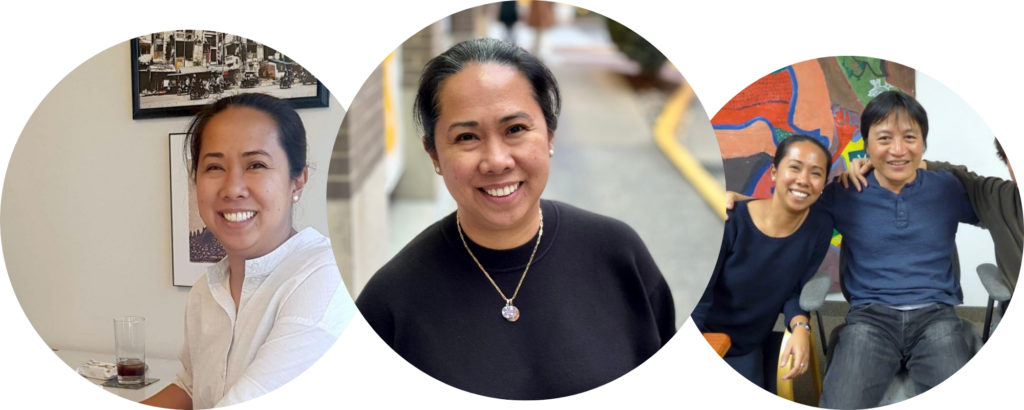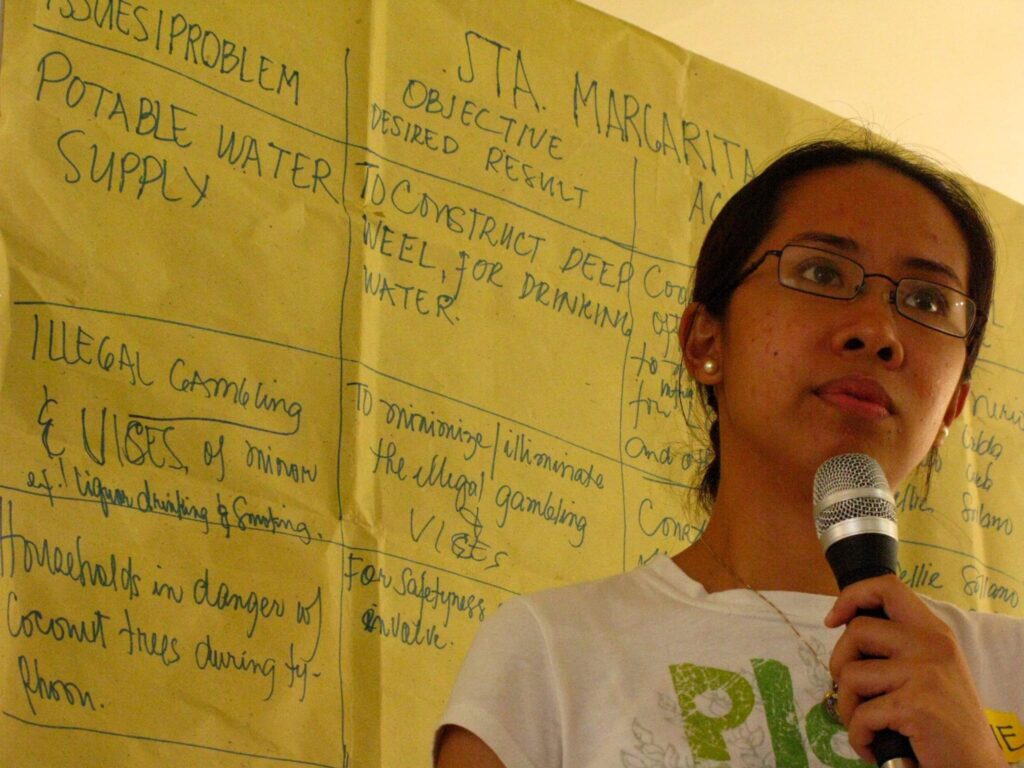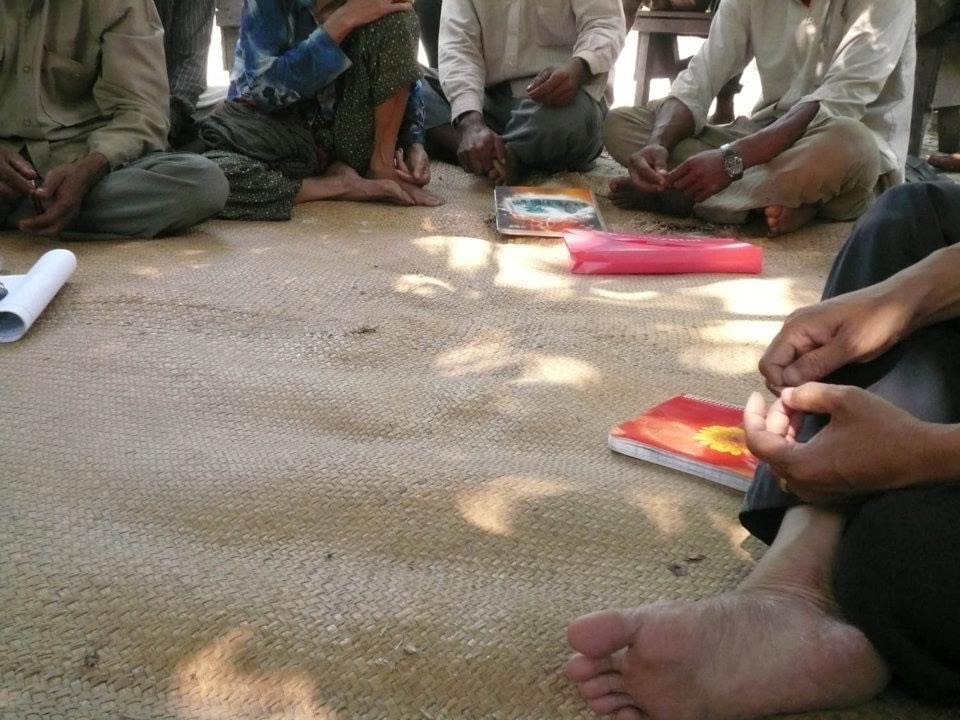In 2007, I embarked on a journey that would completely define my work as a lawyer.

Left and middle: Bobbie Sta Maria. Right: Bobbie with former EarthRights Executive Director, Ka Hsaw Wa. Photo courtesy Bobbie Sta Maria.
In my first week as a new staff member at Saligan, a legal NGO in the Philippines, I was tasked to drive the office car 600 km to the eastern edge of Luzon and take interns and a film documentarian to welcome 55 Sumilao marchers to the island. The Sumilao marchers were Indigenous Higaonon farmers who were walking from the southern island of Mindanao to demand that then President Macapagal-Arroyo stop the impending conversion of their land to an industrial hog farm by the Philippines’ largest conglomerate.
We departed Manila Friday night, and by Saturday morning, had arrived at the port of Matnog in Sorsogon, waving at the marchers who were being ferried by boat between islands. That weekend, I walked over 100 km from Matnog to Legaspi (having relinquished the office car to the support group escorting the farmers on the Luzon leg), slept in a church, and met with and started staffing Kaka, a former Saligan lawyer who was legal counsel to the farmers and was with them for the entire march.
This campaign spanned several months and set the tone for my initial years as a lawyer. During weekdays, I would do my desk work on land and women’s rights from the office, attend network meetings, and appear in court. Come weekends, I would journey to wherever the Sumilao farmers were situated, march or camp with them, provide legal support to Kaka, and then return to my weekday obligations. Once the farmers reached Manila, I would drive to the church or campus where they were spending the night and observe the late-night debriefing sessions – usually impassioned discussions among the farmers, their lawyers, and supporters about the events of the day, the trajectory of the campaign, debating land and family data for potential negotiations, holding each other to account for bad decisions; always culminating in a plan for the next day.
Those grueling yet exhilarating days and nights left me with many lessons I have carried with me over the years: the power of community organizing, legal training, and member-leadership (all the farmers were trained land rights paralegals and organizers); how NGOs and people’s organizations should work together; what it looks like when a community decides on the future they want; the interconnection between community struggles and broader systemic quests for rights; and what it means to fight and win.

Bobbie working and teaching in the field. Photo credits Bobbie Sta. Maria.
The Sumilao farmers still own their land to this day – much of it owned communally, with each family owning a parcel for a home and a small yard. They are organized as a cooperative, collectively own other assets including a community hall and farming equipment, and like many small landowners struggle with the lack of agrarian support services in the country. They have inspired many rural campaigns since, have influenced land laws, and continue to be a force that mobilizes around causes that impact them and the entire country.
I carry this experience with me as I rejoin EarthRights and work with the team in shaping its future. Throughout the application process for the Executive Director position, I was repeatedly challenged to articulate how I engage with and support communities affected by human rights and environmental abuses. The team, in alignment with the organization’s founders and board, staunchly upholds the values of centering the agency and power of people and embracing real solidarity with affected communities, and how law can be a critical tool in strengthening this power. This ethos is reflected in how Katie Redford, one of the organization’s founders, describes what it means for EarthRights to win in its campaigns and legal cases: “The real victory would be if the communities had more power, more agency, more networks and confidence to engineer their own solutions, and be prepared for the next fight, after our case, than they had been before.”

Bobbie working in the field. Photo credits Bobbie Sta. Maria.
The commitment to build power alongside our partner communities is why we developed deep roots in the Amazon and Mekong regions, where local staff work alongside activists from rural and indigenous communities in training, legal, and campaign programs that build and scale community power to address the impacts of large development projects. This same commitment drives our growing climate justice work in the United States, where we use similar strategies to support community resilience and respond to specific challenges faced by our partners.
Through our groundbreaking legal work, we have held accountable some of the world’s biggest companies and institutions, more recently the International Finance Corporation, meaningfully contributing to the building/re-building of power and dignity among our clients; helping pave the way for others to seek justice; and challenging institutions to change.his same connection to struggle and belief in the power of frontline communities is why we show up in legal defense of activists under threat and seek policy responses that expand rather than restrict civic freedoms and end the use of repressive tools.

Bobbie participates in a case meeting in Cambodia with local residents and community members. Photo credits Bobbie Sta. Maria.
The EarthRights model of enabling community-centered and systemic change by shifting power to rights holders through effective and cutting-edge campaigning, training, and litigation is even more critical in our current context. The outlook for 2024 suggests deepening geopolitical tensions; authoritarian elements are poised to capitalize on this by fomenting conflict and suppressing dissent, and certain corporations may seek to exploit instability for their financial gain. This is set against the backdrop of an ever-worsening climate crisis that is exacerbating existing injustices and vulnerabilities, not only because of disproportionate climate impacts but also because of so-called solutions that sacrifice poor, Indigenous, and historically marginalized communities. Meanwhile, the same corporations that we have held accountable for various abuses in the past are continuing to attempt to evade their responsibilities and leave trails of devastation as they wind down involvement in extractive projects.
EarthRights and its partners have spent decades effectively challenging powerful interests and working towards the just future that our partners envision. This is the kind of disruptive, creative, and transformative work needed to address the climate crisis, build truly just climate solutions, and tackle underlying rights issues and patterns of exploitation.
As EarthRights grows in strength and size, we will continue building organizational resilience and better practices of care and support within the team. This will allow us to raise our ambition to meet the demands of the multiple crises we face. We will grow our collaborations in litigation, campaigning, and education by working in more strategic alignment with peers in the climate justice movement and leading with our specialized strengths in community-centered corporate accountability; support more leaders through our training programs, facilitating strategic collaborations among students and alumni, and ensuring alumni support towards real-world impacts; increase our and our partners’ capacity for legal defense and systemic responses against repression; and convene and coalesce bigger and bolder networks of peer lawyers and activists, and facilitate collaborations towards shared goals and strategies.

EarthRights staff and partners outside of the Mitharsuu Center for Leadership and Justice, Mekong region. Photo credits EarthRights International.
The remarkable team at EarthRights is bonded by a deep sense of accountability to our mission and partners. Everyone brings their version of Sumilao, moments in their activism or careers that have led them to believe that communities can persevere towards a better future and that organizations like EarthRights have a meaningful role to play in building this vision. As we expand our ambition to meet the moment, I am confident in our team’s ability to steward resources responsibly, maintain strategic rigor across every area of our work, and hold ourselves to the highest standards as effective and trustworthy partners.






